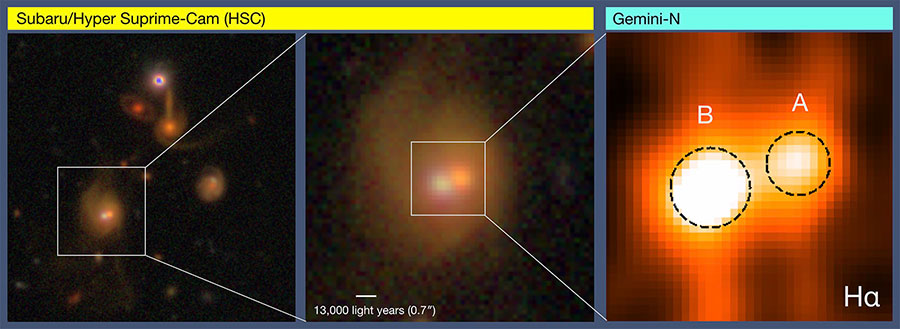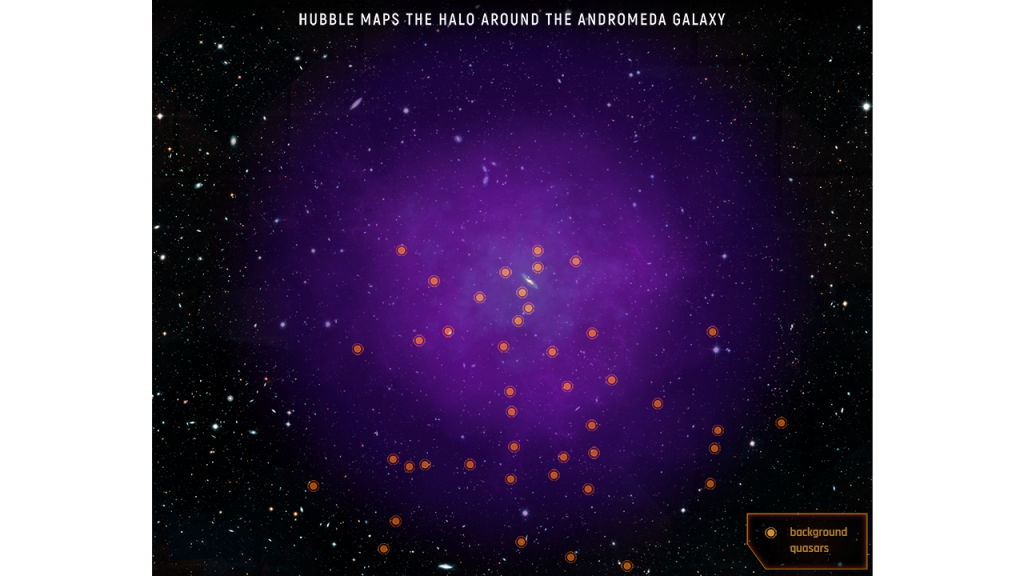Media
Transcript
Today’s news is brought to you by my second cup of coffee because sometimes one is not enough.
In fact, one is not enough for many things today, including supermassive black holes (SMBH). It’s estimated that roughly three in every thousand quasars have two actively feeding black holes in their core. Created during the final stages of large galaxy mergers, these systems are a temporary configuration. In time, these black holes should merge, releasing tremendous bursts of gravitational energy. In the interim, however, they are doing their normal black hole thing of taking infalling material and using it to build disks, throw jets, and quash star formation by blasting out tremendous amounts of light that clear the galactic core.

According to Shenli Tang: In spite of their rarity, they represent an important stage in the evolution of galaxies, where the central giant is awakened, gaining mass, and potentially impacting the growth of its host galaxy.
Unfortunately, finding these systems isn’t only difficult because they are rare; it is also difficult because they are just plain hard to see. Quasars are distant, and distinguishing between one very luminous blob, and a luminous blob that is actually two very close together objects requires using some of the most advanced telescopes in the world.
An international collaboration of astronomers has used the combined abilities of the Subaru Telescope, W. M. Keck Observatory, and Gemini Observatory to search out and find three different binary SMBH quasars. This work appears in The Astrophysical Journal.
According to lead author John Silverman: To make our job easier, we started by looking at the 34,476 known quasars from the Sloan Digital Sky Survey with Hyper Suprime-Cam imaging to identify those having two (or more) distinct centers. Honestly, we didn’t start out looking for dual quasars. We were examining images of these luminous quasars to determine which type of galaxies they preferred to reside in when we started to see cases with two optical sources in their centers where we only expected one.
In the images, 421 systems appeared to have dual cores, but an image alone doesn’t allow the eye or software to distinguish between a system with two SMBHs and glowing accretion disks, and a system with one SMBH that happens to be lined up on the sky with something else that makes it look like there is are two objects at the same distance. To distinguish between actual binary systems and chance alignments the team used spectroscopy to look for two spinning accretion disks at the same redshift. The material around SMBHs can reach orbital speeds of 1000s of kilometers per second – a phenomenon unique to SMBH systems.
From these 421 candidates, they were able to identify three actual binary SMBHs. Two of these systems were already known. This simultaneously proves that their technique works and that these systems are rare and super hard to find.
While this may seem like one heck of a waste of data – looking at 34,000 galaxies to find 421 binary candidates of which only 3 are actually binary systems – the data acquired in this project will be used for other purposes. This is your regular reminder that one person’s noise is another person’s research.
The accretion disks around these systems, and around SMBHs in general, are made up of infalling dust, gas, stars, and inevitably planets and other solar system debris. Astronomers can actually, to a certain extent, determine when an SMBH is about to consume one of these chunkier objects. The gravitational force across the diameter of a star or other extended object can be dramatically different, and these differences in pull can actually pull the object apart. These are called tidal disruption events (TDE), and they often release massive bursts of energy, including X-rays, which can push bubbles into the surrounding interstellar medium. Often isn’t the same as always, however, and theorists have had a chore in sorting what exactly is going on.

According to researcher Tiara Huang: In classical theory, the TDE flare is powered by an accretion disk, producing x-rays from the inner region where hot gas spirals into the black hole. But for most TDEs, we don’t see x-rays—they mostly shine in the ultraviolet and optical wavelengths—so it was suggested that, instead of a disk, we’re seeing emissions from the collision of stellar debris streams.
This theory wasn’t a great match to observations, however, and theorists continued to struggle with this problem. In 2018, a new model postulated that we don’t see the X-rays because they are being blocked by material. This paper, by Enrico Ramirez-Ruiz and Jane Dai, made specific predictions of what should be seen to confirm this idea, and in follow-up observations to a 2018 TDE, they saw exactly what they predicted: emission from hydrogen gas with a double peak showing it is in a spinning disk.
These new results are now published in a paper lead by Huang and appearing in The Astrophysical Journal.
According to Ramirez-Ruiz: This is the first solid confirmation that accretion disks form in these events, even when we don’t see x-rays. The region close to the black hole is obscured by an optically thick wind, so we don’t see the x-ray emissions, but we do see optical light from an extended elliptical disk.
What is interesting about this story is that we had the basic science right all along – those X-rays were getting released during the TDE. What we failed to account for was the environment. Our universe is nothing if not more complex than we like to give it credit for and to understand our reality, we had to make things messier, adding dust and gas and outflows that can obscure the clean physics that we’re most interested in.
Dust and gas really make up far more of the universe than most of us like, but its really hard-to-detect nature can lead to some fascinating realities. For instance, consider Andromeda. This nearby galaxy appears distant and alone, but it turns out, its outer halo reaches well beyond its starry limits and actually stretches halfway to our galaxy.

The core of this nearby system is just visible in dark sites as a smudge in the night sky. Its main disk of stars would appear several moon-widths across if we could see it without a telescope. Now, thanks to a paper also appearing in The Astrophysical Journal, we know its outer halo would appear as wide as the Big Dipper if we could see it at all, which we can’t except as interference in the light of more distant quasars. Project AMIGA (Absorption Map of Ionized Gas in Andromeda) found interference from Andromeda in the light of 43 quasars. This interference took the form of spectral lines signaling the presence of rarified and ionized gas.
It’s amazing to think that Andromeda is interfering with that much of our view of the evening sky. This shows, once again, dust and gas are everywhere, and one person’s noise is always someone else’s data.
Learn More
Rare Encounters Between Cosmic Heavyweights
- Keck Observatory press release
- Kavli Institute for the Physics and Mathematics of the Universe press release
- Subaru Telescope press release
- National Astronomical Observatory of Japan press release
- “Dual Supermassive Black Holes at Close Separation Revealed by the Hyper Suprime-Cam Subaru Strategic Program,” J. D. Silverman et al., 2020 Aug. 26, Astrophysical Journal (Preprint on arxiv.org)
New Observations of Black Hole Devouring a Star Reveal Rapid Disk Formation
- University of California Santa Cruz article
- “Prompt Accretion Disk Formation in an X-Ray Faint Tidal Disruption Event,” Tiara Hung et al., to appear in The Astrophysical Journal (Preprint on arxiv.org)
Hubble Maps a Giant Halo Around the Andromeda Galaxy
- NASA Hubblesite press release
- “Project AMIGA: The Circumgalactic Medium of Andromeda,” Nicolas Lehner et al., 2020 Aug. 27, Astrophysical Journal (Preprint on arxiv.org)
Credits
Written by Pamela Gay
Hosted by Pamela Gay
Audio and Video Editing by Ally Pelphrey
Content Editing by Beth Johnson
Intro and Outro music by Kevin MacLeod, https://incompetech.com/music/


 We record most shows live, on Twitch. Follow us today to get alerts when we go live.
We record most shows live, on Twitch. Follow us today to get alerts when we go live.